Last Updated on February 15, 2023
When it comes to bat-ball games like baseball and cricket, the terms “offense” and “defense” come. However, defense is not our concern today.
By the way, like most games, baseball has two opposing teams called the offensive team and the defensive team. But the question is, what is offense in baseball?
In short, the offense is to score runs. But, there are several facts to know when you want to be clarified about offense and the offensive team’s objective.
What is Offense in Baseball?
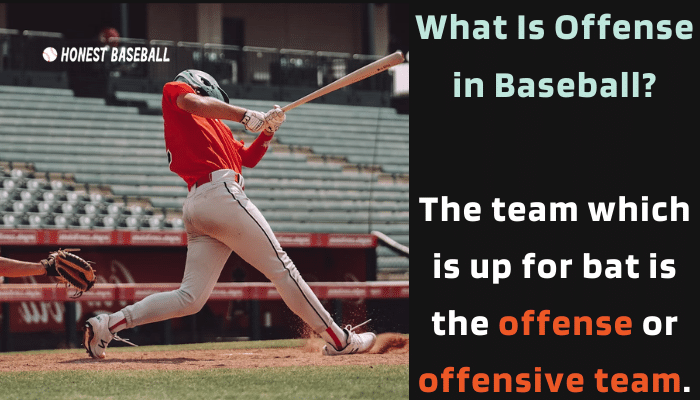
In baseball, two teams play against an opposing team. The teams are called the offensive team and the defensive team.
The batting of the offensive team is the offense in baseball.
The baseball offense objective in baseball, whether in major league baseball or others, is to score runs for the team to win the game. The team who scores more runs than the opposing team wins the game at the end.
The offense consists of two types of players at a time: the batter and the baserunner(s). The offense could have at least a batter on the plate and 1 to 3 baserunners on the bases.
By the way, the baserunner(s) was also the batter who successfully advanced to the base from the plate by hitting or walking.
Ultimately, if one of the baserunners reaches home plate to home plate, he will gain one home run for his team.
Additional Read: What Is Cycle In Baseball? I Bet You Didn’t Know These.
What Are the Offensive Skills in Baseball?
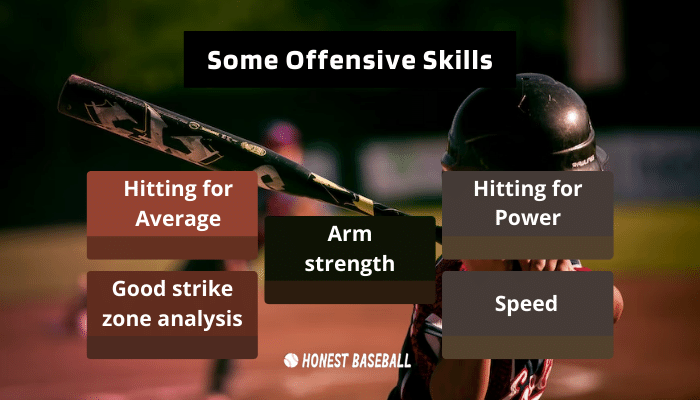
In terms of being a good hitter, a hitter must have the following five skills,
- Hitting for a good batting average.
- Hitting for power-hitting.
- Must have the analyzing ability of strike zone judgment.
- Arm strength
- Offensive speed.
Of all offensive skills, hitting for batting average and power are almost the same. If you can hit powerful hitting and make sure scoring runs, your batting average will be increased.
However, the arm strength comes with the power hitting. So, there is nothing to explore more. By the way, make sure you regularly exercise for fast swings.
Additional Read: How to Hold a Baseball Bat for Maximum Speed and Power?
On the other hand, you need a fast speed for baserunning. But, sometimes, many players have a wild fast speed, but they are not good baserunners in the end.
You need to know how to run, then utilize your fast running speed on the bases.
But you know what, the strike zone analysis is the most crucial skill to have. It is when to swing the bat and when to not. A great and accurate strike zone ability will help you get more walks at bat.
Having a total of 10% walks of an at-bat is a decent ratio to consider a batter good and skilled.
When you know how to control the strike zone, you also know how to master the pitched balls as well.
The Actions a Hitter of Offensive Team Can Do At-Bat
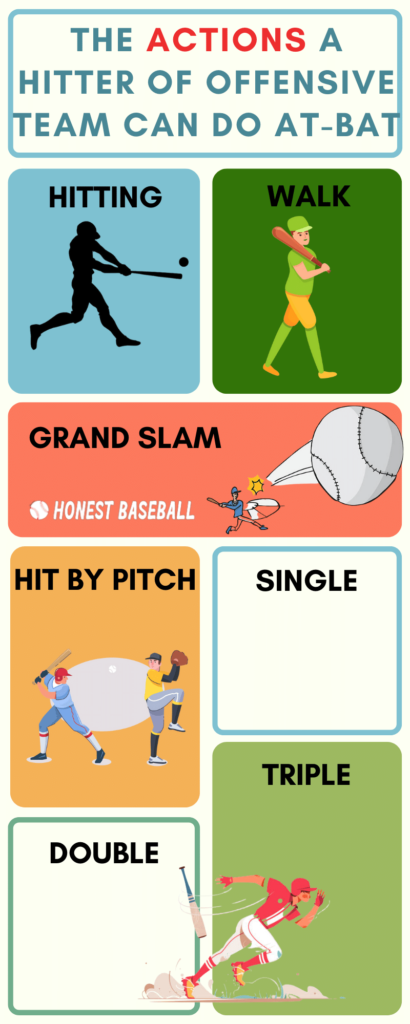
When a batter from the offensive team is at bat (batter on the plate to hit the ball), he can do several actions based on the situation.
- Hitting: A batter’s most important aspect is to hit the ball to bring a home run.
- Walk: The walk is to advance to the first base without the hitter’s face any presentation. It happens when a pitcher throws 4 balls, and there is no strike among them. The batters get the award due to surviving the 4 balls and safely reaching the first base.
- Hit by Pitch: When a thrown ball directly strikes a hitter, this is referred to as being “hit by pitch.” As a result of this, he will be given an award for getting on first base.
- Single: The term “single” refers to the situation in which the batter hits the ball and then runs to first base.
- Double: If the batter hits the ball and gets two runs is double.
- Triple: When the batter contacts the ball and finishes three runs in the same play is triple.
- Grand Slam: The batter hits the ball, the bases are loaded, and he fulfills the cycle to reach the home plate from his initial position of home plate to score a home run.
Positions of Offensive Team
The offensive lineup is comprised of two distinct sorts of positions. They take turns at batting and running the bases. There are several permutations of the baserunners. There might be anything from one to three runners already on base.
Hitters
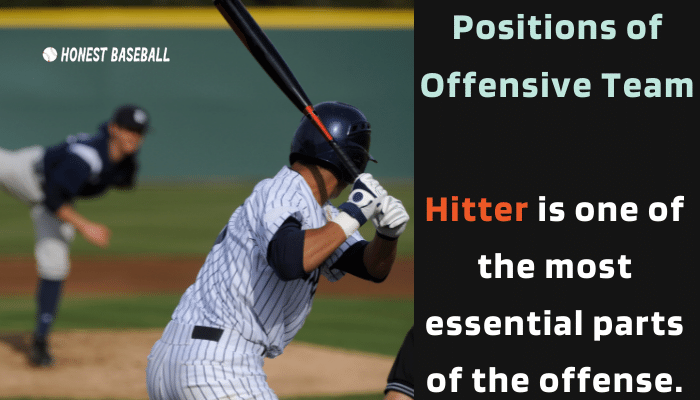
Every player on the offensive team is on the batting lineup to bat. The player who bats first for the team is sometimes referred to as the leadoff hitter.
From the opposing sides, a pitcher throws balls to the hitter to get him out. And the hitter is on the plate to hit and run.
If a hitter does not make contact with the ball as it is moving through the strike zone, he is called a strike. A hitter has three chances of strikes The hitter is considered to have struck out if he gets all three.
Do you know what a strike zone is? It’s an imaginary area actually where there is no physical boundary.
However, the area is considered between the knees and chest of the hitters.
In addition to the batter striking out, a strike may also be called when the batter intentionally or unintentionally swings the bat but is unable to make contact with the ball.
By the way, opposingly to the strikes, the batter is also awarded a walk too. If the batter survives four balls and no strike is called by this time, he will be awarded a walk.
The walk allows the hitters free advancement to the first base.
Baserunners in Offensive Team
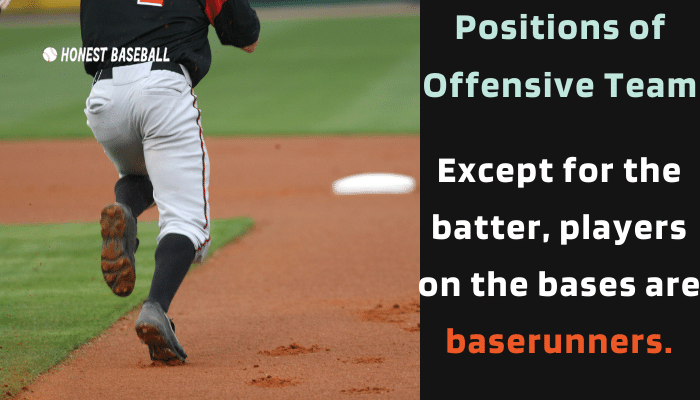
The members of the offensive squad who are now running the bases are referred to as the baserunners. When a hitter advances to first base by a walk, hit by a pitch, or run, he is said to have also become a baserunner.
The batter is considered to have been “tagged out” if any of the fielders manage to get their hands on the ball and touch him before he can advance to the next base.
In addition, the hitter may advance to the first base simply by walking to the plate.
The baseball offenses of the baserunners are in the scoring position.
By the way, one baserunner is allowed in the single base at a time. If all three bases have a baserunner, it is called bases loaded.
On the other hand, if the batter on the plate can hit the ball, and there are two baserunners in base 1 and base 2, they must advance to their respective next bases.
But if there is no hit from the batter, the baserunners are not bound to advance the next base(s).
The Batting Lineup of The Offensive Team
The team manager must implement the batting lineup strategy wisely. And the manager must provide the batting lineup card to the umpire before the game starts.
- The Leadoff Hitter: The offensive player up to bat in the lineup is known as the leadoff hitter. The batter who bats first is expected to have the most previous plate appearances. In addition to that, he is the runner on the squad with the best speed.
- Second Batter: In most cases, the hitter who bats second has excellent contact ability. Most times, they are left-handed batters with the capability of bunting.
- Third Batter: Generally, he has the highest batting average on the team.
- Fourth Batter: The strongest hitter on the team. Also referred to as a cleanup hitter who can take a home run with extra-base hits.
- Fifth Batter: Another excellent hitter who is capable of driving in runs is the fifth hitter in the order. Basically, the third, fourth, and fifth hitters are combined into the same category. The combination is called “the heart of the lineup.”
- From the sixth batter of the lineup, their batting ability of them is decreasing. Batters that come in sixth through eighth positions often do not have a high level of hitting expertise. In addition to this, they have a poor overall average.
- Ninth Batter: The ninth batter of the offensive team is known as the second leadoff hitter in baseball leagues. The ninth batter is actually the lowest capable batter on the team.
Basically, pitchers are the ninth batters in major leagues. They haven’t a good batting average, but they help the leadoff hitters to get runs when they both are on bases.
Do you know the coaches in baseball are called manager? Knowing “Why are baseball coaches called manager” will be a fantastic knowledge gathering.
Who Are the Responsible for Controlling the Ball? Offense or Defense?

As I have already mentioned, the offensive team consists of batters and baserunners. The main goal of the offense is to score runs.
Like other games, many new supporters might think that the offensive team is responsible for controlling the ball in baseball like other games.
But, the interesting fact is that in baseball, the offensive team is not responsible for controlling the ball.
In baseball, the defensive team is in charge of keeping possession of the ball, in contrast to other sports such as cricket, football, and basketball.
The goal of the hitter is to either earn a walk or score runs by advancing through the base paths. On the other hand, the baserunners are responsible for advancing to the next bases to complete a home run.
What is Designated Hitter in Baseball Offense?
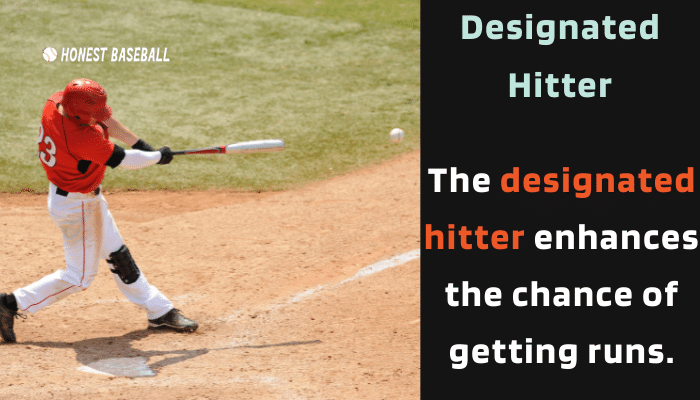
The term designated hitter in baseball is common and popular. Major League Baseball has two divisions: American League and National League.
The managers of the teams playing in the American League are permitted to deploy designated hitters. This is done to increase the likelihood of scoring a greater number of runs. The designated hit is referred to as “DH,” too.
So, what is a designated hitter in baseball?
The designated hitter is the hitter who only hits for the offensive team. He does not field during the team fielding on the baseball field. Generally, one fielder from the defensive team is replaced by the designated hitter.
To be more specific, basically, the pitcher is replaced by the designated hitter to score some quick runs. Because the pitcher is not generally not specialized in batting.
By the way, many leagues do not allow a designated hitter. So, you must know what the league rulebook says about it.
However, using a designated hitter for the offensive team is a fruitful strategy. If the league allows using, you should use a designated hitter. As a result, the team’s coach can increase the team’s offensive power.
Some More Offensive Strategies and Terms
Aside from using a designated hitter, the coaches use some more offensive strategies in baseball. Some of them are as follows.
Hit and Run
Generally, the offensive team plays for hit and run. But, the hitter must not hit all balls.
But in the coach’s call of hit and run, the batter must try to hit the ball and advance for the first base.
Okay, the strategy takes place in two parts, stealing and hitting when the coach class for a hit and run, the baserunners start to steal the bases. In the meantime, the batter also knows he must hit the ball, whatever the ball is.
If the strategy gets successful, the offensive team will get some extra advancements in the next bases.
Here is a perfect hit and run by Jacob deGrom:
Sacrifice Fly
A sacrifice fly is a strategy that a coach uses to advance the baserunner from the third base runner to the home plate. There is a need for a long-fly ball in the outfield. This will help the hitter to be done a sacrifice fly.
In the meantime, the baserunner can move for the next base after he tagged up his previous base. By the way, the batter will not get an “at-bat” with a successful sacrifice fly ball.
Only the third base does not have to be set in order to perform a sacrifice fly. It is a choice that may be made to go from first base to second base. Or even from the second base all the way over to the third base.ll
But as I mentioned, the sacrifice fly is mainly planned to advance from the third base to the home plate. It is when there are fewer than two outs of the offensive team.
Sacrifice Bunt
In order to speed up the process of scoring runs, the sacrifice bunt is sometimes employed. It makes it easier for the runners on base to advance to the next base (s).
The batter basically uses the sacrifice blunt to allow attempting to advance to the next base by the baserunner(s).
In this case, the batter sacrifice himself by getting out to help the baserunner(s) to score runs.
By the way, the batter will not be punished for decreasing his batting average or on-base percentage.
Most often, the batter doesn’t sacrifice himself by his decision. The third base coach generally gives a sign to do so, and the batter does it.
The use of a sacrifice bunt is one way to get from first base to second base in a baseball game. Additionally, from the second base all the way up to the third base.
Base Stealing
Base stealing is an attempt to score a run by advancing to a base from the current base when the pitcher attempts to throw the ball to the batter. The offensive baserunners put their team near to score a home run by stealing a base.
Rickey Henderson is stealing his record-breaking 939th career stolen base.
Squeeze Play
The squeeze play combines stealing bases with bunting in order to score more runs. The batter bunts an all and creates the opportunity for the baserunner on third base to advance to the home plate to score a run.
Brewers win it on walk-off suicide squeeze:
Pinch Runner
The notion of using a different baserunner than the one who is already on base is known as “pinch running.” To improve the team’s chances of scoring runs, the coach may replace the present runner with a runner who has just come off the bench.
Although it often takes place in the bottom of the ninth inning, the coach is allowed to utilize a pinch runner in any inning they see fit. The pinch runner also can field.
The tactic is used when a home team is down by a run, which raises the possibility of drawing level with the visiting team in the game.
In the following video, the pinch-runner Pompey steals two in the 9th but loses the game in the end.
Preventing Double Play Strategy Opposing Team
The double play is to out two players with a single play by the defensive team. Another one of the offense’s strategic triumphs is that they are able to avoid turning a double play.
The baserunner slides in such a way that the second baseman will be distracted by his appearance so that he cannot throw the ball to another base where another baserunner is running to.
Frequently Asked Questions
1. Can you add more than 9 players to your team’s batting order?
Yes, some leagues allow adding of more than nine players in the batting order of the offensive team. But, this doesn’t happen in all leagues.
By the way, the extended number of players varies from league to league.
For example, according to the Little League Rules, you can call the batting order “continuous batting order.” There s no restriction on how many batters can bat.
There is also no way to change or switch out any of the players in the game. If there is a player that is running behind schedule to get to the game, the head coach has the ability to substitute for him once he finally arrives on the field. However, the coach is not permitted to change the order of batters in the lineup.
2. Is it a pitcher offense or defense in Major League Baseball?
The pitcher is the most important player on the defensive team. So, yes, the pitcher is a defense.
3. What makes a good baseball player?
Along with having great physical strength, a baseball player must have some mental strength to be a good baseball player.
You can consider developing self-confidence, emotional control ability, mental toughness, playing in a stressful situation, controlling the pressure in a crucial situation, etc.
Aside from this, an approach with aggression to make things happen would be another great dessert of your psychological development part.
Wrap Up
So, now you know what is offense in baseball. When the offense team bats, they bat for scoring runs. So, all strategies of batting are about how to score runs.
As the offense consists of batter and baserunners, they are both responsible for scoring runs. In addition, to get runs, a batter must have several offense skills, including strike zone analyzing, power hitting, fast speed, etc.
Post You Also Might be Interested In:
What Does FPS Mean In Baseball?
What Does DFA mean in Baseball? A to Z Detail
What Does WHIP Mean In Baseball? A Comprehensive Explanation
Baseball Terminology | Honest Baseball
What Is an Eephus Pitch? | A Mystery?

Hello everyone. My name is Jason Butler, and I live in California, America. I was a professional AAA Minor League Baseball player. I lost my chance of playing MLB for injury issues, but I did not lose my love for baseball. I attended the coaching training program and am now working as a coach in a small school in San Diego.
I always love to share my experience and knowledge if that can help you. Play baseball, and stay fit.
